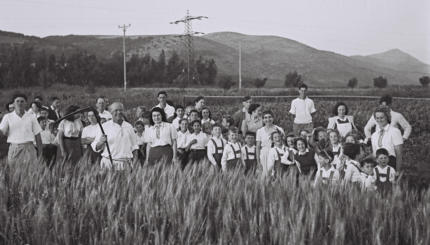This commentary is provided by special arrangement with American Jewish World Service. To learn more, visit www.ajws.org.
The first verse of
Megillat Ruth
reads like the headlines of a tragic and all-too-familiar news story. The defective and unstable government of the judges leads to famine. Bethlehem—the city of bread—becomes the city of starvation. Lack of food security results inevitably in forced migration—a journey of sorrow characterized by homelessness, vulnerability, health risks and ultimately, death.
The second verse of Megillat Ruth reminds us that famine, forced migration and their associated risks are not only the stuff of this particular story, but are perennial struggles in the Torah: Mention of Efrat calls to mind the tragic death of Rachel when fleeing from Lavan (Genesis 35:16); Elimelekh’s name evokes that of Avimelekh, the king of Gerar—villain of the famines and consequent wanderings that threatened the patriarchs and matriarchs (Genesis 20 and 26). Hunger and homelessness are not one-time events of the megillah, nor the lot of strangers in a distant land; rather, Megillat Ruth reminds us that they are part of our national heritage during the periods in which we have lacked just and effective rule.
But the megillah also suggests a solution to this recurring plight: the inclusion of women in the work of building a strong family, society and the eventual establishment of good government. Ruth’s selfless heroics bring salvation not only to herself, her mother-in-law Naomi and her family, but also to the Jewish people as a whole. By leaving everything she knows behind and courageously starting a new family, Ruth turns catastrophe into a vibrant future. By giving birth to Oved (Ruth 4:17), the grandfather of David, Ruth paves the way for the Davidic dynasty—a government of “justice and righteousness” (II Samuel 8:15) that not only represents the kingdom of Heaven but also brings in its wake the ability for every individual to dwell “safely, each man under his grape vine and under his fig tree” (I Kings 5:5). At the hand of Ruth, famine has the potential to be abolished, replaced instead by security, sustainability and justice.
In taking on the unknown and forging a new nation, Ruth employs the tools available to a woman at the time—her sexuality and her fertility—to secure the future of the nation that she knows is her destiny. She descends to the threshing floor and challenges Boaz to break with accepted norms to marry a Moabite and become her partner in nation-building. By both working within and challenging the norms of her society, she proposes inclusion as a model for communal advancement.
Pulitzer Prize-winning writers Nicholas Kristof and Sheryl WuDunn advance a similar thesis in their recent book, Half the Sky: Turning Oppression into Opportunity for Women Worldwide. According to them, in many Global South communities women are considered among the most effective changemakers, perhaps because they are able to shift the trajectory of their societies from within the home—as Ruth did.
Empowering fellow women and advancing their status not only frees women from oppression, but also allows them to—as the authors put it—“hold up their half of the sky,” contributing to their nations’ overall economic growth. Money in the hands of women, Kristof and WuDunn suggest, is also more likely to be directed to family welfare, nutrition and education than that earned by their male counterparts. And including women at all levels of society has been demonstrated to reduce conflict and strengthen stable governments—both of which the Bible tells us are so essential to personal security. Thus, empowering women is perhaps the single most important factor in improving the situation of a community as a whole.
Megillat Ruth is a precursor to this idea, demonstrating that the visionaries who transform societies need not be kings, strong male leaders or even patriarchs. Indeed, the book makes repeated parallels between Ruth and Judaism’s founding father, Abraham, suggesting that her role is equally important as his in forging a strong future. Both are characterized by tremendous chesed—kindness; and both are portrayed as courageous migrants who leave the land of their fathers to embark on unknown journeys for the sake of God and the Jewish people. By replacing the archetypal patriarch with a woman in this story, Megillat Ruth reminds us of the “half the sky” that is borne by women, and gives hope that by including women at all levels of society, a familiar script can be rewritten.
megillah
Pronounced: muh-GILL-uh, Origin: Hebrew, meaning "scroll," it is usually used to refer to the scroll of Esther (Megillat Esther, also known as the Book of Esther), a book of the Bible traditionally read twice during the holiday of Purim. Slang: a long and tedious story or explanation.


